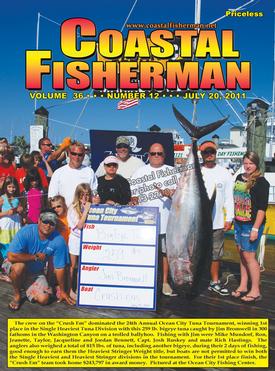


Article by Pat Schrawder
 WIRELESS INSTRUMENTS- THE NEW WAVE??
WIRELESS INSTRUMENTS- THE NEW WAVE??
In an effort to keep readers of this column up-to-date on the latest in marine electronics, I try to bring a variety of new products to your attention. Never before have I written about an item that I am not crazy about, but I think I’ve found one that is worth mentioning. I say this because it may or may not be something that becomes a trend. I’m talking about wireless instruments and,
in particular, wireless transducers.
There is no doubt that faulty wiring can be a big source of problems with electronics. If a wire gets chaffed and corrodes or the connection breaks, you will have equipment failure. Likewise, the time and effort needed to run wires from point A to point B on your boat can often make installation difficult, more costly and, sometimes, impossible. Therefore, eliminating the need for running wires would seem to be an attractive solution.
There is one company, Tacktick, out of the UK that specializes in just that - wireless instruments. The company formed in 1996 with the introduction of the world’s first solar powered electronic compass. Their products are designed with sailboats in mind more so than power boats, but they have produced some interesting products. All of them are designed with the idea of being solar powered and transmitting to each other via wireless technology. In 2007, they were purchased by the compass manufacturer, Suunto and in June of 2011 Suunto was bought out by Raymarine who had previously been bought out of bankruptcy themselves by Flir camera systems. It is not clear what plans Raymarine has for the product line.
What I found most interesting is Tacktick’s approach to depth finders. The transducer is mounted on the transom with a short cable running to a black box. That black box is powered by a solar panel and the box transmits wirelessly to the instrument main unit. It is a clever concept and it will be interesting to see if other manufacturers latch on to the technology. Right now, the Tacktick line is using the industry leader, AirMar’s transducers to connect to their black box.
Several questions need to be considered with this concept, however. If there is no sunlight, does the instrument immediately fail or is there a battery that the solar panel charges? How long will it supply the needed power? Does the solar panel produce sufficient power to support larger items than small digital instruments? These questions must be explored before this wireless concept can be advanced to cover other major items of electronics. Additionally, it is prudent to point out that the system is not completely wireless since you need wires to connect both the transducer and the solar panel to the black box. The advantage is that those units are most likely to be located close together.
With the government’s push for more solar usage, it is safe to say that some innovators out there are working to create smaller solar panels and storage batteries with the capability of delivering larger amounts of power for longer periods of time. When that happens, I’d say wireless marine electronics will be right at the forefront. But don’t expect it to be cheap. If you would like more information on Tacktick, check out their website: www.tacktick.com
Pat and her husband, Larry are owners of L&L Marine Electronics on Golf Course Road in West Ocean City, MD.